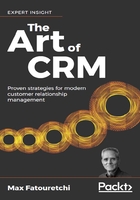
Chapter 2. Getting to Know Your Customer
The end-to-end story of the customer's journey
In this chapter, we are going to explore how getting to know your customer, otherwise known as KYC, and subsequently storing and representing the relevant customer data in your CRM system, can improve operational efficiency, reduce the cost of operations, and improve customer satisfaction. Understanding your customer through maintaining and managing the relevant customer information is at the heart of any successful business and CRM strategy. In fact, it's safe to say that customer knowledge is the essential ingredient to a business being successful.
Building a single, sophisticated, role-based, 360-degree customer view that can capture, process, and present all the relevant relationship data is at the heart of understanding and knowing your customer. This is a central repository and, in this case, data access is based on the role and power that a user has in the organization.
This data could cover anything from a history of interactions with the customer to a list of products and services that the customer has with the company.
But beyond that, it could also include the customer's satisfaction level, a list of open and closed complaints, and general information about the customer interactions, and channels, which in turn could lead to a better understanding of the customer from a business perspective.
With this knowledge, the company will be able to better analyze, target, and personalize future client interactions; create an accurate pipeline to automate the processes in sales, marketing, services; and, as a result, better orchestrate its business.
A common definition of a single customer view is an aggregated and holistic presentation of client data that's being held by a company or by its business units. This data could come from multiple sources, and it may be stored and viewed in one place, often as a single page. In larger companies, where multiple business units operate, this may occur with multiple views that represent the same data in different contexts, depending on business needs and the role a user has within the company. In this case, we call it a role-based 360-degree client view.
Throughout this book, I may use different terms for the single customer view, including:
- 360-degree client view
- Client single view (CSV)
- Single customer view (SCV)
- Single customer repository
However, I will always refer to the preceding definition in terms of a CRM solution.
In almost all CRM projects that I have been involved in throughout the last 15+ years, a single customer view, or 360-degree client view, has been the central element of any CRM system. Without a doubt, it has almost always been the function used in order to build the foundation for all the other requirements. However, as we will explore later, in some scenarios this may not be the case.
Likewise, CSV remains the most popular and useful feature at the start of any CRM journey. However, this approach requires that you undertake it correctly from the start in order to avoid running into issues that could hinder your progress. This topic is the focus of this chapter and will be covered extensively.
Almost every CRM implementation today, regardless of the company's size, market segment, and the functional areas it needs to provide to the business (customer service, sales, or marketing), is involved in the 360-degree client view, at some point. Indeed, the 360-degree client view is the central repository of your customer knowledge. For your company, it acts as the foundation of your communication and business relationship with your customers.
This is indeed the most important element in your CRM implementation, regardless of the type of your business or market segment you are operating in. Therefore, in this chapter, we are going to take a deep dive into building a comprehensive 360-degree client view.